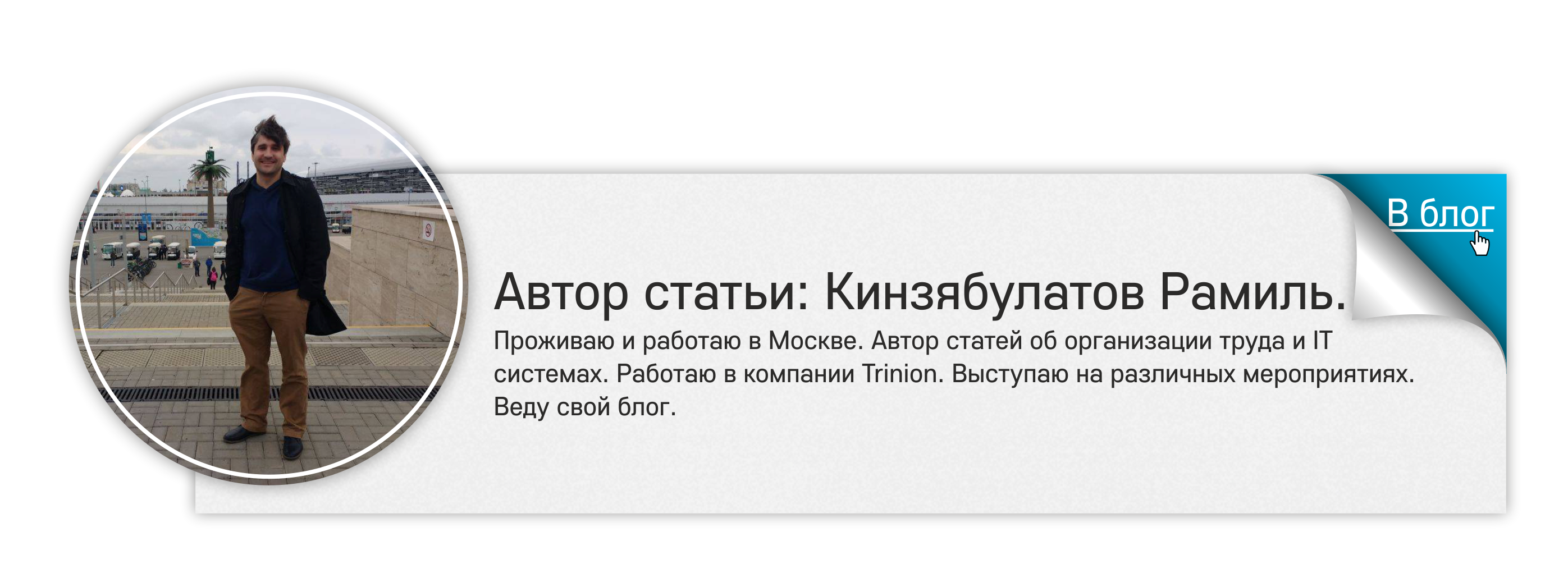Zoho CRM. Overview
 My acquaintance with CRM began about a year ago, when a client first ordered me to implement CRM for customer relationship management. To begin with, we analyzed various CRMs for choosing the optimal one: Amo CRM, Sugar CRM, Sales Force and many others were tested by me. After two weeks of analysis, we chose Zoho CRM for many reasons, which will be revealed in this article.
My acquaintance with CRM began about a year ago, when a client first ordered me to implement CRM for customer relationship management. To begin with, we analyzed various CRMs for choosing the optimal one: Amo CRM, Sugar CRM, Sales Force and many others were tested by me. After two weeks of analysis, we chose Zoho CRM for many reasons, which will be revealed in this article.During the year I implemented Zoho CRM on 8 different projects and gained a lot of experience in working with this system, which I want to share with you. In this article I will give an overview of Zoho CRM and try to explain the structure of what this system consists of, why my choice fell on it, what nuances there are in working with the system. I will try to avoid rigorous language and explain everything in accessible language. So, let's begin.
What is CRM?
To get started is to deal with the very concept of CRM. CRM is an abbreviation that stands for Customer Relationship Management (Customer Relationship Management System). There are many definitions of what is CRM. Here I will give the one that seems to me the most accurate. I previously quoted it in my Guinness article - “The Perfect Pint of Beer”. Case excellent CRM solutions.
The CRM system, which is also often called client management, is a business approach. His goal is to create, develop and strengthen relationships with carefully selected clients, increase customer benefits, increase corporate profits, and thus maximize investor profits.(from the book "CRM Guide. A Path to Improving Customer Management." By Adrian Payne).
Thus, CRM is a whole complex of tools, events, information technologies aimed at achieving the goal: to create, develop and strengthen relationships with customers. Zoho CRM is a part of this complex, its IT component. Zoho CRM gives the customer the opportunity to do what he knows best: sales. Workflow Automation Zoho takes over.
')
Licenses
Zoho CRM is a saas solution, that is, the program works only through a web browser, and no programs are installed on the user's computer.
UPD: You can try Zoho CRM completely free of charge if you register by the link.
To get started with Zoho CRM you need to buy a license. A license is needed in order to have access to the system for one month or a year. Each license gives the right to connect to the username and password as many times as necessary, for example, from a computer, laptop and smartphone. Licensing occurs by users, i.e. One license corresponds to one user who is registered in CRM. You can run as many simultaneous sessions as one user. This is important to understand in order to determine the number of licenses you need to buy. For example, if a company has 3 managers who use only CRM system reports, you do not need to buy 3 licenses, one will be enough. But the number of users registered in Zoho CRM cannot be greater than the number of licenses, this must be understood. That is, to give access to a new user, you must either deactivate another user, or buy a new license.
Subscription
http: // 

Zoho CRM Delivery Versions
With the number of licenses sorted out, now you need to select a tariff.
Zoho CRM offers 4 tariffs : Standart, Professional, Enterprise, CRM Plus. From the selected tariff depends on the functionality of the CRM system. I consider Enterprise the optimal tariff, which has all the necessary functions for small and medium businesses. The cost of one Enterprise license for small and medium-sized businesses is acceptable and at the time of this writing is $ 35 per month per user.
http: //

What does the Enterprise give us? This version has all the functions of Standart and Professional plus additional functions, without which it is difficult to imagine the work of CRM. When introducing CRM for me, the critical point is the ability to integrate with telephony. And starting only with the Enterprise version, such integration is possible. In versions of Standart and Professional integration with telephony is not provided. I will not dwell on all the advantages of Enterprise over other versions. Learn more about the capabilities of each system here .
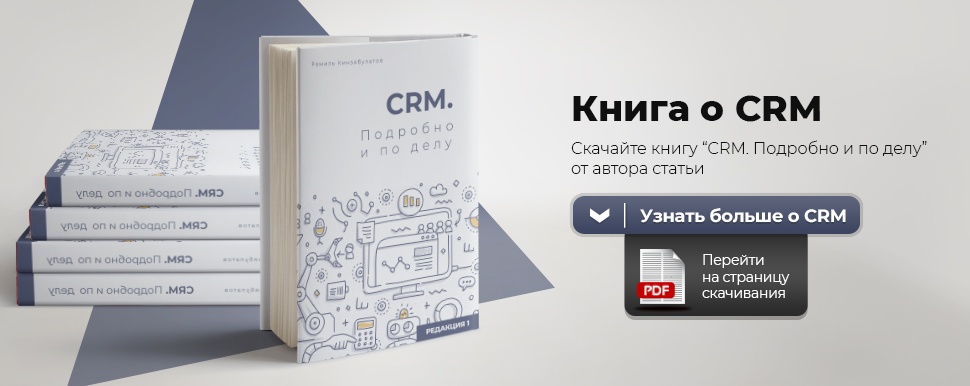 Once you have chosen the type of license, you need to understand what are the components of Zoho CRM and what are its capabilities. The functionality of the system is very impressive, and the format of the article does not allow to describe everything. Therefore, I will go through the components and the capabilities of Zoho CRM, which I have been involved in projects and which I consider the most significant when working with the system.
Once you have chosen the type of license, you need to understand what are the components of Zoho CRM and what are its capabilities. The functionality of the system is very impressive, and the format of the article does not allow to describe everything. Therefore, I will go through the components and the capabilities of Zoho CRM, which I have been involved in projects and which I consider the most significant when working with the system.System components
Administrator and Users
The user is the one who has access to the system. Having a unique username and password, the user can log in to Zoho CRM an unlimited number of times from different devices. Users are of two types:
- Administrator.
The administrator has full access to Zoho CRM and can configure access rights, as well as control other users, configure modules and the appearance of the system, connect plug-ins, third-party systems, etc. Administrator rights must have a user who will configure the system. It is very important that you never lose access to the system. It happens that the administrator does not accidentally install administrator rights, and can not get into the system. This can not be in Zoho CRM: here the administrator can not remove the full access to the system. There is always one admin in Zoho. The system controls it.
- Other users.
Modules
Modules are the essence through which all the work in the Zoho CRM system takes place. It is like the bricks of which the system consists. The modules are presented in the system in the form of tabs, the appearance of which is customizable. The modules have fields. Among the fields you will see “First Name”, “Last Name”, “Telephone Number,“ Email ”,“ Status ”,“ Stage of the Deal ”and others. In Zoho you can add your own fields. Fields have the broadest possibilities of customization and organization. But back to the modules. There are 2 types of modules in Zoho CRM:
- Pre-installed (basic) modules.
- Custom modules.
http: //

4 base modules
Lead
- This is a potential customer who has shown interest in your company in any way. This is the very first stage at work. This is not a client yet, but work is already underway with it. How to contact it is too early to start. Leads are generated from different sources. The list of sources includes exhibitions, email campaigns, web-forms, cold dialing, direct marketing and others. Leads can be created manually or automatically (for example, when applying from a site sent via the built-in web form, or when calling from an undefined number). You can automatically assign a task to this lead (for example, “Call a Lead”) and have this task go to a specific manager. With the lead, work is carried out, after which it can be converted into a Contact or Counterparty and into a Potential Transaction.
Contact
Is a person with whom the user interacts directly. Contact is the core module of the entire system, which is responsible for any interactions with the client. Contacts are the source of strength of any business. Therefore, the more information about the client, the more successful the business will be. The Contacts module in Zoho CRM is a powerful, personalized way to save all the necessary contact information in one window. The Contact module has everything you need to know about the client:
- Phone numbers
- Al. letters
- Tasks
- Reminders
- To-do lists
- Documents
- And much more
How it works? Imagine that the contact is calling the user. The user’s name is displayed on the user's screen, and the user can open a card of this contact, where all the information on the client will be presented in one window: his recent orders, recent interactions with him, open tasks on the contact. Thus, the user during the conversation will be able to build the logic of work with this contact. Upon completion of an incoming call, the system will save this call in the list of interactions and offer to create a task with a reminder.
Counterparty (Account)
Is an organization, a company associated with a contact. Multiple contacts can be subordinated to one counterparty. Basically, all work with clients is carried out in the Contacts module, but the Counterparty module is needed in order to group the work for the company as a whole. The Counterparties module also consists of custom fields, but here, unlike Contacts, contains legal information for a particular organization.
Potential Transaction
- This is the module that is responsible for controlling the transaction as a whole and which tracks the specific transaction in the sales chain. Here you can record at what stage the transaction is, what is the probability of winning the transaction, transaction history, transaction amount, responsible, etc. The fields here, as well as in other modules, are customizable.
Deal with Zoho CRM
Now I will tell you what a step by step transaction looks like in Zoho CRM.
- The normal sales process starts with a lead generation campaign. This may be an email campaign, an exhibition, advertising in Yandex or other promotion systems.
- In Zoho CRM, manually or automatically create leads based on the received data. This can be a completed application on the site, an incoming email message or a business card. You can write a rule in Zoho CRM, so that when you create a lead, he receives an email message with a greeting.
- Leads are assigned to different users (each lead has a responsible user). Users get tasks to work with leads. This can be done manually or automatically (if a corresponding rule is written). The task specifies the topic, deadline, type of operation that must be performed and, of course, the lead to which the task is attached.
- Users work with leads: make calls, send email or SMS, hold meetings, recording all interactions in the system.
- Next you need to qualify leads, non-working leads need to be removed from the system.
- After the interaction took place, the lead showed interest and revealed its potential - it is converted into a counterparty, contact and a potential deal. This happens by pressing a single key, after which our client moves from the Lead module to the selected module.
- Work continues until the transaction is won. Or not lost.
As you can see, the workflow is quite transparent and has extensive automation capabilities. Now I want to go to the features and capabilities of CRM, the most popular projects.
Zoho CRM features and capabilities
Data import
I want to pay special attention to data import. Importing data into Zoho CRM is easy, there are no restrictions on importing data. The process is very simple and fast. You upload a file in the XLS or CSV format, map the fields, and load the data. The field names in Zoho CRM are the column headings of your table. It is very convenient that you can always take and cancel the operation, all data that was in this import will be deleted from the system.
API
The API is the first thing I noticed when choosing a CRM system. What is an API? It is a tool for integrating one software with another. I really liked the description of the API in Zoho CRM, I really liked their documentation, the services they provide. A CRM system is not a thing in itself, it must exist within a single information field, it must be well integrated. And if the system is good in itself, but poorly integrated, then this system will not work. The API in Zoho CRM is very convenient and provides excellent integration with various services.
http: //

The API has certain limits . Depending on the Zoho CRM tariff chosen, the amount of data that can be uploaded or downloaded varies.
The minimum you can use in the Enterprise version is 4000 requests per organization per day.
The maximum is 25,000 requests per day per organization or 500 requests per user, and the limit is lower.
One request at a time is possible:
- add or read up to 200 entries
- delete or update up to 100 entries
That is, if you have 3 users, then you can make 3 * 500 = 1500 requests. 1500 is less than the minimum of 4000, which means you can make 4000 requests.
If you have 10 users, then you can make 10 * 500 = 5000 requests. 5000 is more than the minimum equal to 4000, but less than the maximum equal to 25 000 - you can make 5000 requests.
In the maximum you can only rest when the number of users is more than 50.
Thanks to the excellent API, Zoho CRM, as I said, integrates with completely different services. Consider some of them.
Telephony Integration
One of the things that is very important for the client when working with CRM and without which it is impossible to imagine a CRM system, in my opinion, is the automatic recording of all possible employee interactions with the client by phone:
- recording incoming calls in the system, their duration
- initiating outgoing calls from the system
Appearance of incoming call
http: // 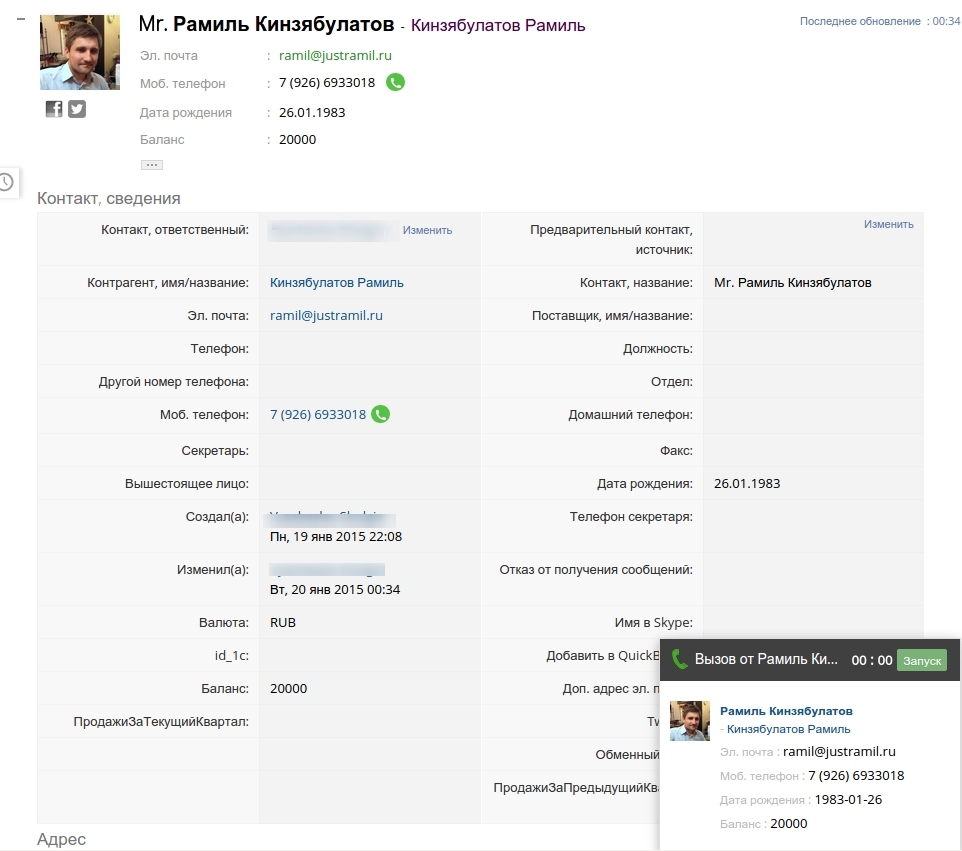

Appearance of outgoing call
http: // 

Many CRM systems therefore did not “take off”: it’s hard to imagine that an employee manually clogged all the data on his calls. Zoho CRM has it all right.
Zoho CRM integrates with telephony through PhoneBridge technology. CRM can be integrated with various telephony systems, at the time of this writing it is:
- Avaya
- Asterisk
- Elastix
- Twilio
- Ringio
On all the projects I have carried out the integration of Zoho with the Asterisk system. The process is fairly easy and simple, as Zoho provides all the necessary tools. I did not check the rest of the telephony systems, because Asterisk has become a quality standard for me.
Integration with SMS aggregators
Integration with SMS aggregators in Zoho CRM is done using the webhook method. Webhook is one of the tools that allows you to integrate with the most common systems without writing lines of code. You create a webhook, specify the parameters (for example, a contact, phone number, SMS text, translit) and link it to a specific event.
Appearance of webhook
http: // 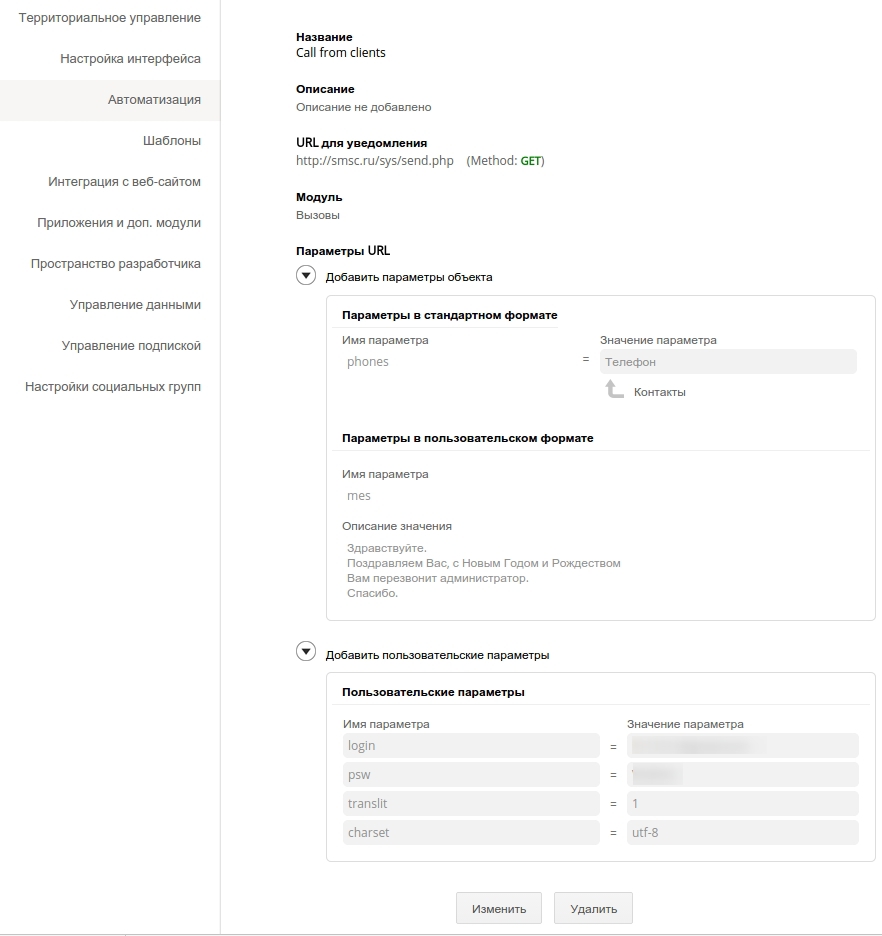

For example, you want to send an SMS to a user with a lead creation notification. The Webhook service allows you to simplify this task by sending notifications to a third party every time you create a new event within CRM. This event can be anything: creating a contact, closing a business transaction or updating a client’s request.
The speed of the system is very high, I did not notice any problems.
Integration with email providers
Zoho provides default integration with Zoho Campaigns and Mailchimp. One of the most convenient features is that when sending out, the system automatically calculates non-working email addresses and notifies the users themselves. If, for example, the client’s email address is incorrectly filled, or the address no longer exists, then the system will identify these addresses when sending out and send a notification to the user. The address can be clarified and corrected, or deleted.
Integration of Zoho CRM with other Zoho services.
Zoho is a developer of many great services besides Zoho CRM, and provides integration with them, which is configured with a few clicks. Some of my clients use ZOHO Campaigns for email newsletters, the Zoho Project for managing projects. There were no problems with integration, everything works out of the box, and is thought out very well.
Integration with other Zoho products
http: // 

Integration with 1s
One of the very important features of Zoho CRM is integration with 1c. Thanks to the API integration is quite easy. Integration with 1c allows you not to enter the client twice: we enter it only in Zoho CRM, and in 1c the client appears automatically. Due to this, the user does not waste time doing double work, avoids errors and duplication of data.
http: //

In turn, accounting information is transferred from 1c to Zoho CRM: accounts, orders, balance, etc. So, on one project I had an interesting task: the customer needed Zoho CRM to see his previous purchases for the previous card and current quarter Based on this data, the user builds the logic of working with the client. The corresponding fields were created in the client card, and the information from 1c was loaded there and updated as changes occurred. This task was solved without any problems.
As we can see, Zoho CRM really integrates well with various systems and services, the list of which can be continued. But let us turn now to the other possibilities that Zoho CRM provides.
Zoho Reports
I will pay attention to such a tool as Zoho Reports. Zoho Reports is a report designer for Zoho CRM. With it you can create almost any report in any section. There are basic reports in the system, which are quite good, but in addition, you can easily create your own report. Examples of Zoho Reports:
- by managers and groups of managers
- by product and product group
- by revenue
- on calls: their performance, duration, theme, etc.
- by deals: their stages, amounts, probability of winning
- by tasks: their stages, deadlines
- temporary reports: per day, week, month
- and many, many other reports.
Report Panel in Zoho CRM
http: // 

http: //

Zoho Creator
It should also be noted a tool such as Zoho Creator - a system for creating your own applications within Zoho. Creator seamlessly integrates with Zoho CRM. How it works, I'll show by example. I have a client - a network of beauty salons. They have a so-called service entry. Zoho Creator has created the Customer Record application, in which its own fields were created. Including in one of the fields, you can specify a link to the contact in Zoho CRM. This Client Record was derived as a separate module. Zoho Creator is the topic of a separate article, but I can say that this system has very broad capabilities.
Zoho Creator Appearance
http: // 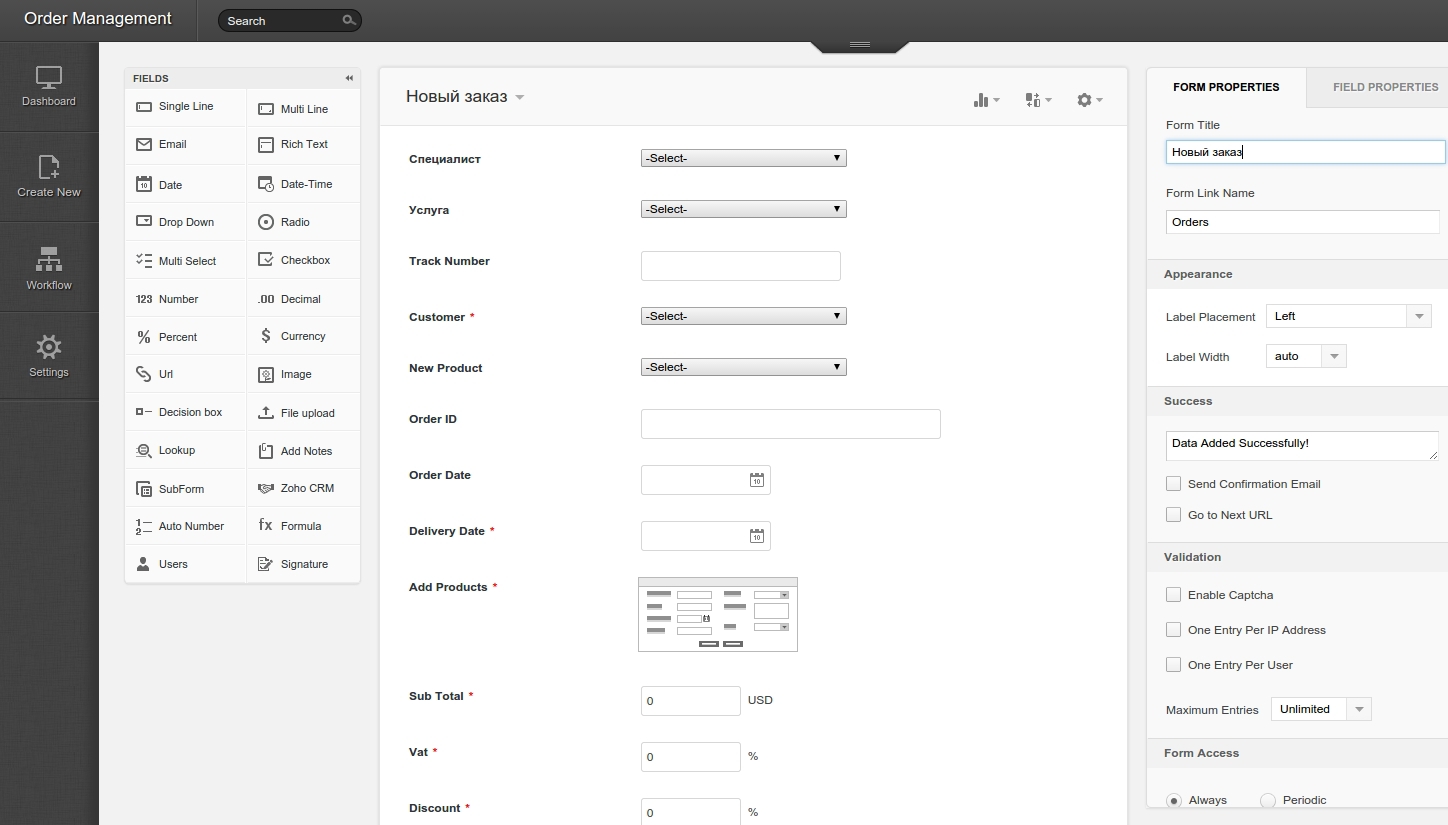

Web forms
Most businesses are based online and require web-forms in order to attract leads from landing pages, collect feedback from visitors and invite customers to future events. In Zoho CRM, the process of creating web forms is very simple: it is carried out using the form building service by dragging and dropping fields. This allows you to build a contact form site or profile yourself. You just need to drag the required fields using the service of the built-in WYSIWYG editor. You can also upload files, mark required fields, insert fields for additional data using hidden fields and much more.
Tabs
Tabs are tabs in the top Zoho menu. Tabs are a key element of the interface through which all information with which the user works is displayed. There are two types of tabs:
- Zoho tabs They display as tabs the modules of the system itself.
- web tabs They display third-party sites as tabs.
What does web-tab look like?
http: // 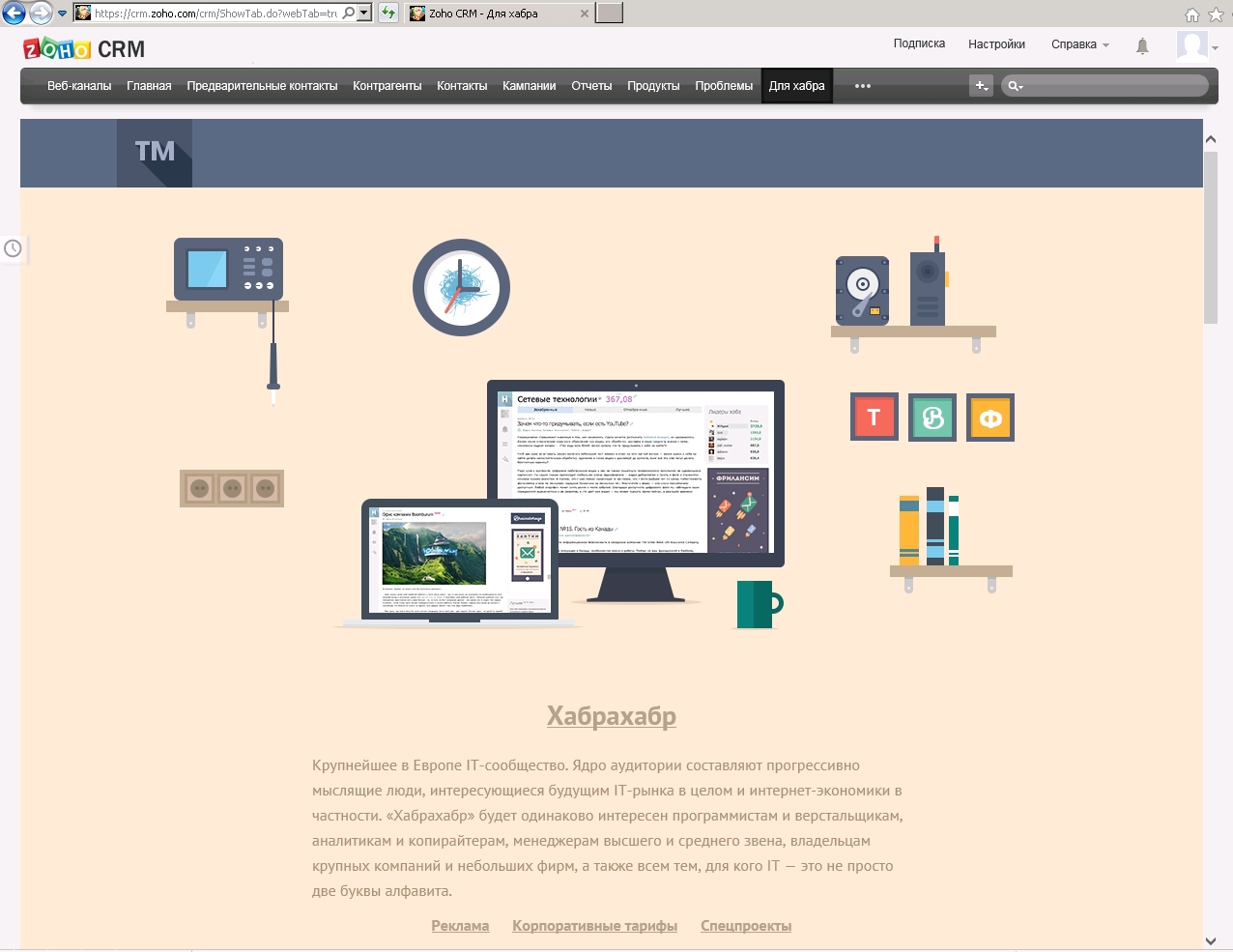

Tabs Zoho and web-tabs can be combined in one panel, and the user can customize the order of tabs, their names and visibility as they wish.
Zoho CRM also allows you to create groups of tabs containing a set of tabs that are combined by a sign. For example, a tab group for sales managers is one set of tabs; a tab group for a manager is a completely different set.
Workflow
Thanks to Workflow, you can automate all the routine processes of Zoho CRM by writing rules. For example, a client wants to automatically send email to new leads who have left their contact details on the site. It is enough to create a new rule in which you need to specify the required module (in our case, this is the Lead), time to perform actions (during creation), and type of operation (we have this Email, here you need to select a letter template). This is a fairly simple example; Workflow provides much wider and varied automation capabilities.
Appearance Workflow
http: // 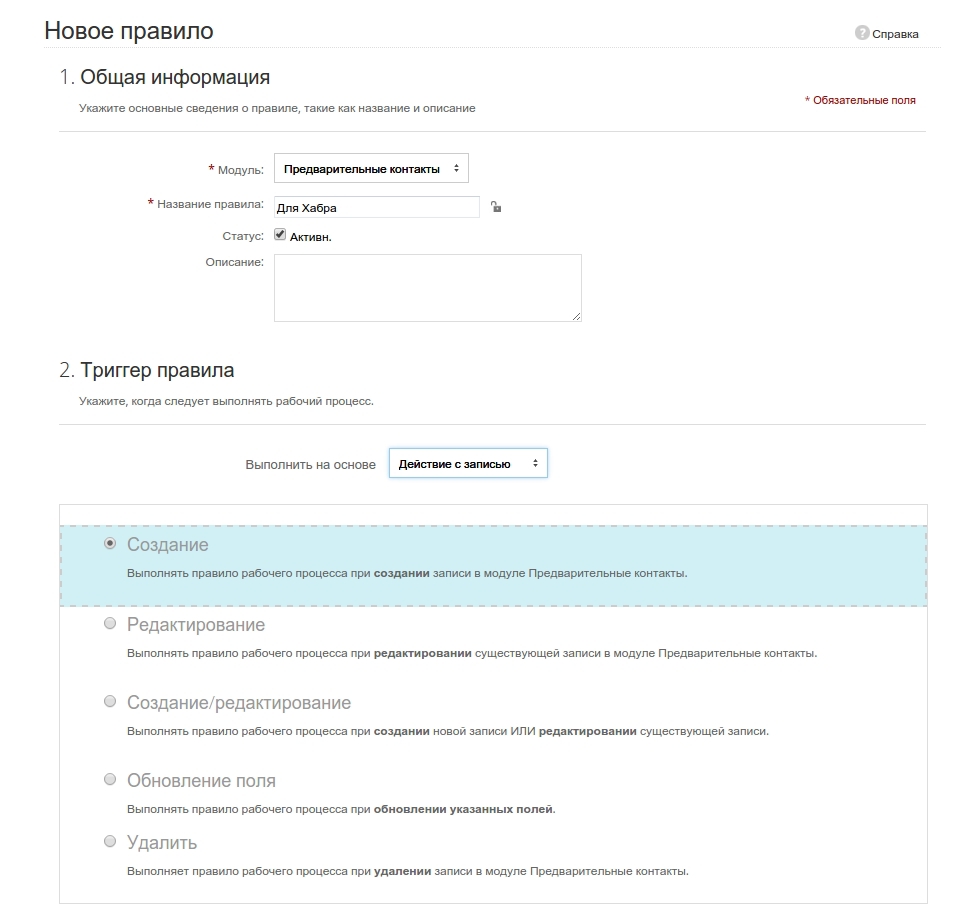

Support
http: //
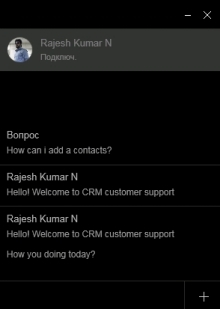 So to speak. I am delighted with the support service Zoho CRM. And although mostly Indians are responsible (as I can guess from the name in the chat and photo), they help great. We have to communicate in English, but my clients had enough google translator to communicate with customer support. I am very pleased that the communication takes place on the chat, and almost always the operator answers within a minute. They then send the communication history to the post office with the necessary information.
So to speak. I am delighted with the support service Zoho CRM. And although mostly Indians are responsible (as I can guess from the name in the chat and photo), they help great. We have to communicate in English, but my clients had enough google translator to communicate with customer support. I am very pleased that the communication takes place on the chat, and almost always the operator answers within a minute. They then send the communication history to the post office with the necessary information.In conclusion of the article, I note once again that the functionality of Zoho CRM is impressive, and the format of the article does not allow to describe everything. To summarize: why is Zoho CRM a great tool for managing customer relationships and why I recommend it:
- Zoho is a very flexible and highly customizable system.
- The cost of the license is acceptable for small and medium businesses.
- Excellent API providing integration with completely different systems and services.
- High-level workflow automation
- The ability to create web forms without programming
- Excellent localization in Russian
New from 04/17/2015: Integration with telephony is now in the tariff
Professional
http: // 

New from 09/17/2018: ZOHO official site of ZOHO official partner. Ztrinion.ru
Source: https://habr.com/ru/post/248281/
All Articles
